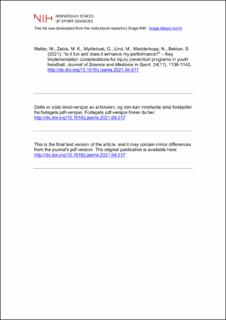| dc.contributor.author | Møller, Merete | |
| dc.contributor.author | Zebis, Mette K. | |
| dc.contributor.author | Myklebust, Grethe | |
| dc.contributor.author | Lind, Martin | |
| dc.contributor.author | Wedderkopp, Niels | |
| dc.contributor.author | Bekker, Sheree | |
| dc.date.accessioned | 2023-11-17T11:49:59Z | |
| dc.date.available | 2023-11-17T11:49:59Z | |
| dc.date.created | 2021-08-06T10:35:46Z | |
| dc.date.issued | 2021 | |
| dc.identifier.citation | Journal of Science and Medicine in Sport. 2021, 24(11), 1136-1142. | en_US |
| dc.identifier.issn | 1440-2440 | |
| dc.identifier.uri | https://hdl.handle.net/11250/3103231 | |
| dc.description | I Brage finner du siste tekst-versjon av artikkelen, og den kan inneholde ubetydelige forskjeller fra forlagets pdf-versjon. Forlagets pdf-versjon finner du på sciencedirect.com / In Brage you'll find the final text version of the article, and it may contain insignificant differences from the journal's pdf version. The definitive version is available at sciencedirect.com. | en_US |
| dc.description.abstract | Objectives: We aimed to determine the use of injury prevention exercises and injury prevention exercise programs in Danish youth handball and investigate coach and player experiences, beliefs and attitudes of injury and their prevention. Design: A mixed-methods design consisting of cross-sectional quantitative surveys and qualitative interviews. Methods: We surveyed 481 youth (14–18 years old) handball players and their 33 coaches about their use of injury prevention exercises, and attitudes towards injury and their prevention. Additionally, we interviewed five coaches and three players about barriers and motivational factors for implementing injury prevention programs. Results: Players (71%) and almost all coaches reported performing injury prevention exercises for the shoulder, knee, and ankle. Yet few players (4%) and coaches (1%) reported performing the established full injury prevention programs systematically. Players were willing to implement programs to reduce injury risk (84% agreed) and enhance performance (88% agreed). Key factors influencing program uptake were lack of awareness of evidence-based injury prevention programs and lack of handball-specific exercises. Coaches and players identified continued education and training as vital facilitators in this setting, and all coaches agreed that injury prevention should be an essential part of coach education. Conclusions: While Danish youth handball players and coaches seemed to recognize the importance of injury prevention, the use of established programs was marginal. Experiences, beliefs, and attitudes about injury and injury prevention influenced program uptake and should be addressed through continued education and training in this context in combination with making the programs more handball specific. | en_US |
| dc.language.iso | eng | en_US |
| dc.subject | youth sports | en_US |
| dc.subject | athletic injuries | en_US |
| dc.subject | exercise | en_US |
| dc.subject | behavior | en_US |
| dc.subject | practice | en_US |
| dc.subject | knowledge | en_US |
| dc.title | “Is it fun and does it enhance my performance?” – Key implementation considerations for injury prevention programs in youth handball | en_US |
| dc.type | Peer reviewed | en_US |
| dc.type | Journal article | en_US |
| dc.description.version | acceptedVersion | en_US |
| dc.source.pagenumber | 1136-1142 | en_US |
| dc.source.volume | 24 | en_US |
| dc.source.journal | Journal of Science and Medicine in Sport | en_US |
| dc.source.issue | 11 | en_US |
| dc.identifier.doi | 10.1016/j.jsams.2021.04.017 | |
| dc.identifier.cristin | 1924332 | |
| dc.description.localcode | Institutt for idrettsmedisinske fag / Department of Sports Medicine | en_US |
| cristin.ispublished | true | |
| cristin.fulltext | postprint | |
| cristin.qualitycode | 1 | |
